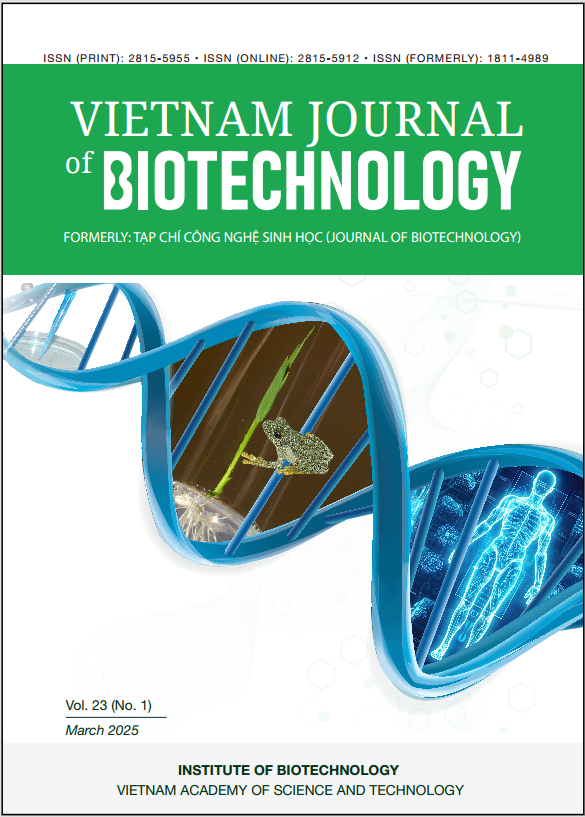Whole exome sequencing identified a pathogenic variant c.1620C>G in the FGFR3 gene in a Vietnamese patient
Author affiliations
DOI:
https://doi.org/10.15625/vjbt-22379Keywords:
c.1620C>G, FGFR3, hypochondroplasia, p.N540K, Vietnamese patientAbstract
Fibroblast growth factor receptor (FGFR3)-related diseases can present a wide spectrum of symptoms, ranging from mild shortening of limbs to lethal skeletal dysplasia. Diagnosing FGFR3-related diseases can be challenging given phenotypic overlap with other skeletal dysplasia. The appropriate diagnosis of FGFR3-related diseases relies on a combination of clinical and radio-imaging data, and molecular analyses. In this report, we present a Vietnamese female with short stature, shortening of long bones, short and broad femoral neck, and squared and shortened ilia. Whole exome sequencing and variant filtering were performed in the proband to identify a disease-causing variant. Sanger sequencing was carried out to confirm the presence of the variant in the proband as well as in her parents. The result showed that a c.1620C>G (p.N540K) in the FGFR3 gene was found in the proband. The parents and sister carried normal alleles. The variant in the proband is de novo. The variant was classified as a pathogenic variant in the ClinVar database. Therefore, the proband was diagnosed with hypochondroplasia. This is the first report of pathogenic variant c.1620C>G (p.N540K) in the FGFR3 gene identified in the Vietnamese patient.
Downloads
References
Adzhubei, I., Jordan, D. M., & Sunyaev, S. R. (2013). Predicting functional effect of human missense mutations using PolyPhen-2. Current Protocols in Human Genetics, 76, 7.20.1-7.20.41. https://doi.org/10.1002/0471142905.hg0720s76
Almeida, M. R., Campos-Xavier, A. B., Medeira, A., Cordeiro, I., Sousa, A. B., Lima, M., et al. (2009). Clinical and molecular diagnosis of the skeletal dysplasias associated with mutations in the gene encoding Fibroblast Growth Factor Receptor 3 (FGFR3) in Portugal. Clinical Genetics, 75(2), 150–156. https://doi.org/10.1111/j.1399-0004.2008.01123.x
Bellus, G. A., Bamshad, M. J., Przylepa, K. A., Dorst, J., Lee, R. R., Hurko, O., et al. (1999). Severe achondroplasia with developmental delay and acanthosis nigricans (SADDAN): Phenotypic analysis of a new skeletal dysplasia caused by a Lys650Met mutation in fibroblast growth factor receptor 3. American Journal of Medical Genetics, 85(1), 53–65.
Bonaventure, J., Rousseau, F., Legeai-Mallet, L., Le Merrer, M., Munnich, A., & Maroteaux, P. (1996). Common mutations in the fibroblast growth factor receptor 3 (FGFR 3) gene account for achondroplasia, hypochondroplasia, and thanatophoric dwarfism. American Journal of Medical Genetics, 63(1), 148–154. https://doi.org/10.1002/(SICI)1096-8628(19960503)63:1<148::AID-AJMG26>3.0.CO;2-N
Cheung, M. S., Cole, T. J., Arundel, P., Bridges, N., Burren, C. P., Cole, T., et al. (2024). Growth reference charts for children with hypochondroplasia. American Journal of Medical Genetics. Part A, 194(2), 243–252. https://doi.org/10.1002/ajmg.a.63431
French, T., & Savarirayan, R. (1993). Thanatophoric Dysplasia. In M. P. Adam, J. Feldman, G. M. Mirzaa, R. A. Pagon, S. E. Wallace, L. J. Bean, K. W. Gripp, & A. Amemiya (Eds.), GeneReviews®. University of Washington, Seattle. http://www.ncbi.nlm.nih.gov/books/NBK1366/
Horton, W. A. (1997). Fibroblast growth factor receptor 3 and the human chondrodysplasias. Current Opinion in Pediatrics, 9(4), 437–442. https://doi.org/10.1097/00008480-199708000-00021
Krejci, P., Salazar, L., Kashiwada, T. A., Chlebova, K., Salasova, A., Thompson, L. M., et al.(2008). Analysis of STAT1 activation by six FGFR3 mutants associated with skeletal dysplasia undermines dominant role of STAT1 in FGFR3 signaling in cartilage. PloS One, 3(12), e3961. https://doi.org/10.1371/journal.pone.0003961
Linnankivi, T., Mäkitie, O., Valanne, L., & Toiviainen-Salo, S. (2012). Neuroimaging and neurological findings in patients with hypochondroplasia and FGFR3 N540K mutation. American Journal of Medical Genetics. Part A, 158A (12), 3119–3125. https://doi.org/10.1002/ajmg.a.35642
Mortier, G. R., Cohn, D. H., Cormier-Daire, V., Hall, C., Krakow, D., Mundlos, S., et al. (2019). Nosology and classification of genetic skeletal disorders: 2019 revision. American Journal of Medical Genetics Part A, 179(12), 2393–2419. https://doi.org/10.1002/ajmg.a.61366
Murali, C. N., McDonald-McGinn, D. M., Wenger, T. L., McDougall, C., Stroup, B. M., Sheppard, S. E., et al. (2019). Muenke syndrome: Medical and surgical comorbidities and long-term management. American Journal of Medical Genetics Part A, 179(8), 1442–1450. https://doi.org/10.1002/ajmg.a.61199
Nguyen, N.-L., Ngoc, C. T. B., Vu, C. D., Nguyen, T. T. H., & Nguyen, H. H. (2020). Whole exome sequencing as a diagnostic tool for unidentified muscular dystrophy in a Vietnamese family. Diagnostics (Basel, Switzerland), 10(10), 741. https://doi.org/10.3390/diagnostics10100741
Pauli, R. M. (2019). Achondroplasia: A comprehensive clinical review. Orphanet Journal of Rare Diseases, 14(1), 1–1. https://doi.org/10.1186/s13023-018-0972-6
Prinos, P., Costa, T., Sommer, A., Kilpatrick, M. W., & Tsipouras, P. (1995). A common FGFR3 gene mutation in hypochondroplasia. Human Molecular Genetics, 4(11), 2097–2101. https://doi.org/10.1093/hmg/4.11.2097
Raffioni, S., Zhu, Y. Z., Bradshaw, R. A., & Thompson, L. M. (1998). Effect of transmembrane and kinase domain mutations on fibroblast growth factor receptor 3 chimera signaling in PC12 cells. A model for the control of receptor tyrosine kinase activation. The Journal of Biological Chemistry, 273(52), 35250–35259. https://doi.org/10.1074/jbc.273.52.35250
Richards, S., Aziz, N., Bale, S., Bick, D., Das, S., Gastier-Foster, J., et al. (2015). Standards and guidelines for the interpretation of sequence variants: A joint consensus recommendation of the American College of Medical Genetics and Genomics and the Association for Molecular Pathology. Genetics in Medicine: Official Journal of the American College of Medical Genetics, 17(5), 405–424. https://doi.org/10.1038/gim.2015.30
Savarirayan, R., Ireland, P., Irving, M., Thompson, D., Alves, I., Baratela, W. A. R., et al. (2022). International Consensus Statement on the diagnosis, multidisciplinary management and lifelong care of individuals with achondroplasia. Nature Reviews. Endocrinology, 18(3), 173–189. https://doi.org/10.1038/s41574-021-00595-x
Shiang, R., Thompson, L. M., Zhu, Y. Z., Church, D. M., Fielder, T. J., Bocian, M., Winokur, S. T., et al. (1994). Mutations in the transmembrane domain of FGFR3 cause the most common genetic form of dwarfism, achondroplasia. Cell, 78(2), 335–342. https://doi.org/10.1016/0092-8674(94)90302-6
Steinhaus, R., Proft, S., Schuelke, M., Cooper, D. N., Schwarz, J. M., & Seelow, D. (2021). MutationTaster2021. Nucleic Acids Research, 49(W1), W446–W451. https://doi.org/10.1093/nar/gkab266
Talebi, F., Ghanbari Mardasi, F., Mohammadi Asl, J., Bavarsad, A. H., & Tizno, S. (2017). Identification of a novel missence mutation in FGFR3 gene in an Iranian family with LADD syndrome by Next-Generation Sequencing. International Journal of Pediatric Otorhinolaryngology, 97, 192–196. https://doi.org/10.1016/j.ijporl.2017.04.016
Toydemir, R. M., Brassington, A. E., Bayrak-Toydemir, P., Krakowiak, P. A., Jorde, L. B., Whitby, F. G., et al. (2006). A novel mutation in FGFR3 causes camptodactyly, tall stature, and hearing loss (CATSHL) syndrome. The American Journal of Human Genetics, 79(5), 935–941. https://doi.org/10.1086/508433
Wilkes, D., Rutland, P., Pulleyn, L. J., Reardon, W., Moss, C., Ellis, J. P., et al. (1996). A recurrent mutation, ala391glu, in the transmembrane region of FGFR3 causes Crouzon syndrome and acanthosis nigricans. Journal of Medical Genetics, 33(9), 744–748. https://doi.org/10.1136/jmg.33.9.744
Xue, Y., Sun, A., Mekikian, P. B., Martin, J., Rimoin, D. L., Lachman, R. S., et al. (2014). FGFR3 mutation frequency in 324 cases from the International Skeletal Dysplasia Registry. Molecular Genetics & Genomic Medicine, 2(6), 497–503. https://doi.org/10.1002/mgg3.96
Downloads
Published
How to Cite
Issue
Section
Funding data
-
Vietnam Academy of Science and Technology
Grant numbers KHCBSS.01/22-24







